
Background information
The Ariadne's thread that runs through all Liv Interior products
by Pia Seidel

Sustainable design should be timeless - it must not go out of fashion. Designer Cornelia Stahl has researched what this means and is now putting it into practice for the home textiles label "#Lavie".
Cornelia Stahl and her fellow student Emanuela Zambon actually had a clear plan: to take off with their newly founded label Zambon & Stahl after completing their Master's degree. But when they met Oliver Balsiger, the executive board member of Balsiger Textil, during their final year at university, things turned out differently. They were both so enthusiastic about his idea of producing sustainable home textiles that they wanted to be part of it. "At the time, home textiles were less of a focus when it came to sustainability compared to fashion," explains Cornelia. "But bed linen lies directly on the skin, takes up a large area and changes the look of a room."
Even before completing their master's degrees, the designers were still helping to create patterns for the first collection from #Lavie. Four years later, I meet Cornelia with Oliver in the first showroom in Zurich, which still smells of fresh colour and wooden parquet flooring. Cornelia shows me around the space and tells me where her enthusiasm for textiles comes from and what sustainable design requires.
Even during her apprenticeship as a decorative designer, Cornelia was fascinated by how much a fabric offers as a surface for pattern design. "You can print a pattern, weave it and interpret it in so many ways," she explains. "That motivated me to go on to study textile design." At Lucerne University of Applied Sciences and Arts, she is taught from day one how much influence each new design can have on the environment. This characterises the young designer. During her studies, she therefore focuses on upcycling and finds a way to recycle old parquet flooring, for example. [[image:38706301 "Cornelia Stahl has long been interested in what makes a pattern durable."]]
Some time later, she dedicated her Master's thesis to fashion. Cornelia wants to find out what characteristics timeless patterns have. At the same time, her fellow student Emanuela explores the term "unisex" in fashion. They ask different people about the colours, patterns and items of clothing that they have had in their wardrobe for the longest time.
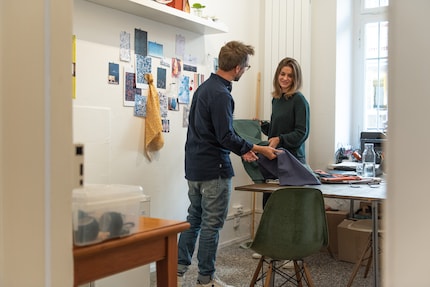
The answers from the master's thesis are incorporated into the designs for the first #Lavie collection 2016. After all, what we like to wear is also an indication of what we like to surround ourselves with at home. Clear shapes such as checks, stripes and dots as well as two-colour patterns are considered timeless and unisex, according to the survey. Colours such as black, white, blue, red and green are particularly popular. A particularly long-lasting item of clothing is also either plain or flashy, but nothing in between. That's why designers have since opted for restrained patterns with muted colours. This also corresponds to what Cornelia is wearing during the visit: a dark green jumper and straight-cut blue jeans.
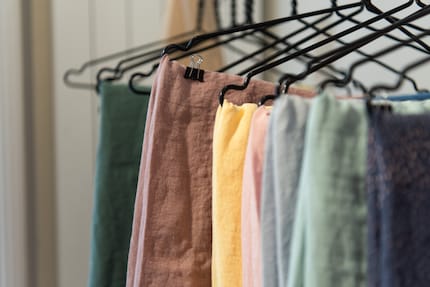
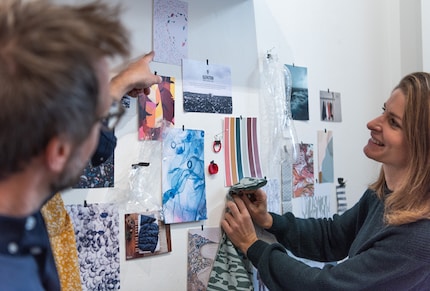
Only two to three new colours or prints will be added to the #Lavie plain range each year. Cornelia and Emanuela are in close dialogue with Oliver and the team to determine these. A topic is jointly determined for each new collection. This provides a topic of conversation every time.
"We discuss the most when creating the mood board," explains Cornelia. "Every image on the board is scrutinised so that everyone is talking about the same thing." The designers then draw their first sketches by hand and in the same place. They digitise the sketches later. This allows them to continue working on them individually from anywhere. At the end, they bring the sketches back to the team before they go into production in Portugal.
Designing as a duo sets Cornelia and Emanuela apart from most creative minds. It's common in the industry to make a name for yourself alone. Current design greats such as Patricia Urquiola, Jamie Hayon and Sebastian Herkner name their brands after themselves - no matter how many minds are behind them. "You have to be able to let go of your own ideas. That's how something new is created." The same applies to the printing of the prints, she says. Sometimes there are designs that can't be printed as desired.
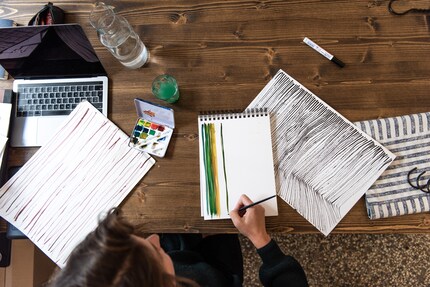

Oliver, who has a background in business administration, handles most of the communication with production. He liaises with the manufacturers in Portugal and reports if the first fabric sample does not meet expectations. "It hurts when a print is more pixelated than expected or an element is omitted due to the limited printing options," says Cornelia. I put so much heart and soul into the design. It's difficult. Although I know that it's not obvious to outsiders what's missing." However, if the product has already been produced, throwing it away purely because of the look is out of the question. The designer prefers to prioritise her personal concerns.
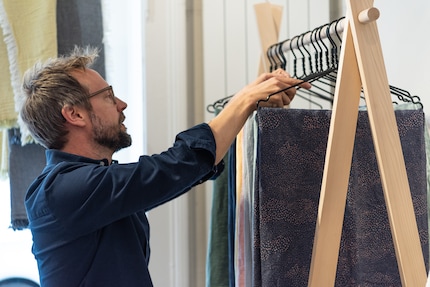
In the master's thesis surveys, a high-quality material was the prerequisite for all favourite pieces.
#Lavie favours linen and has also been using GOTS-certified organic cotton for two years. The second label, Journey Living, also uses organic satin and Tencel. The one- or two-colour patterns for the bed linen and Finn models are created using pigment printing. They are applied to the fabric and then fixed. Compared to reactive printing, where the ink penetrates the fibre during the process, this printing method requires less water. Especially when only one side is printed, as with the Finn model.
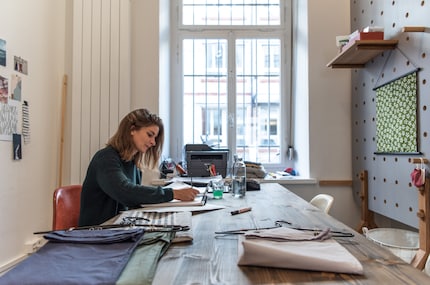
The individual designs from #Lavie are intended to be simple and timeless so that they can withstand fashion trends. On the other hand, the single-colour and two-tone patterns should be easy to combine with each other. Since Cornelia knows from her research back then that one and two colours seem to stand the test of time, she doesn't mind the restrictions when designing. She does want to design unique patterns, but not at any price. She prefers to concentrate on the big picture and the development of the label. "We don't want #Lavie to be fast-moving. We want to grow, but we want to do so consciously and sustainably."
Like a cheerleader, I love celebrating good design and bringing you closer to everything furniture- and interior design- related. I regularly curate simple yet sophisticated interior ideas, report on trends and interview creative minds about their work.
Interesting facts about products, behind-the-scenes looks at manufacturers and deep-dives on interesting people.
Show all